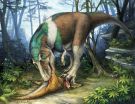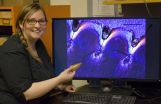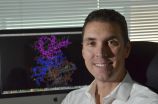Research with bite
Unique tooth structure allowed predatory dinosaurs to efficiently crunch flesh and bone
2015-07-28
(Press-News.org) The Tyrannosaurus rex and its fellow theropod dinosaurs that rampage across the screen in movies like Jurassic World were successful predators partly due to a unique, deeply serrated tooth structure that allowed them to easily tear through the flesh and bone of other dinosaurs, says new research from the University of Toronto Mississauga (UTM).
The research, published in the journal Scientific Reports, was conducted by Kirstin Brink, a post-doctoral researcher in the Department of Biology at UTM; Professor Robert Reisz of the Department of Biology and the UTM vice-principal of graduate studies; and colleagues at the Royal Ontario Museum (ROM) and the National Synchrotron Radiation Research Center in Taiwan.
Brink and her colleagues determined that this deeply serrated--or sawlike--tooth structure is uniquely common to carnivorous theropods such as T. rex and Allosaurus, and even one of the first theropods, Coelophysis. Other extinct animals had teeth that were superficially similar, but it was the special arrangement of tissues inside the tooth that strengthened and improved the function of the teeth. The deep serrations made them much more efficient at chomping on bones and ripping flesh of larger animals and reptiles, and allowed them to prosper for about 165 million years as fearsome, top predators.
The only reptile living today that has the same superficial tooth structure is the Komodo dragon, native to Indonesia. It, too, preys on larger animals.
"What is so fascinating to me is that all animal teeth are made from the same building blocks, but the way the blocks fit together to form the structure of the tooth greatly affects how that animal processes food," Brink said. "The hidden complexity of the tooth structure in theropods suggests that they were more efficient at handling prey than previously thought, likely contributing to their success."
She and her colleagues also found that the unique arrangement of tooth tissues did not develop in response to these carnivores chewing hard materials. They determined this by examining samples of dinosaur teeth that had not yet broken through the gums, as well as samples from mature dinosaur teeth. Unlike humans, reptiles grow new teeth throughout their lifetimes.
"What is startling and amazing about this work is that Kirstin was able to take teeth with these steak knife-like serrations and find a way to make cuts to obtain sections along the cutting edge of these teeth," said Reisz. "If you don't cut them right, you don't get the information.
"This brought about a developmental explanation for the tooth formation; the serrations are even more spectacular and permanent."
Brink and colleagues used a scanning electron microscope - a very powerful microscope -- and a synchrotron - a microscope that allows the user to understand a substance's chemical composition -- to do a thorough examination and analysis of tooth slices from eight carnivorous theropods, including T. rex, Allosaurus, Coelophysis and Gorgosaurus. The samples came from various museums, including the ROM, the Canadian Museum of Nature in Ottawa, and the Royal Tyrrell Museum in Alberta.
Reisz noted that his research lab has focused on teeth in the context of their workings within the jaw, making possible a broader understanding of the value of this discovery.
INFORMATION:
MEDIA CONTACTS:
Kirstin Brink, PhD
Department of Biology
905-569-4399
kirstin.brink@mail.utoronto.ca
ELSE PRESS RELEASES FROM THIS DATE:
2015-07-28
Diseases like Alzheimer's are caused when proteins aggregate and clump together. In a world first, EPFL scientists have successfully distinguished between the disease-causing aggregation forms of proteins. The finding can help change pharmaceutical treatment of neurodegenerative diseases.
Because of our increasing lifespan, diseases like Parkinson's, Huntington's and Alzheimer's are on the rise. They are caused when certain proteins misfold and aggregate together, forming clumps that damage neurons in the brain and spinal cord. This aggregation evolves progressively through ...
2015-07-28
PITTSBURGH, July 28, 2015 - By studying the yeast used in beer- and bread-making, researchers at the University of Pittsburgh School of Medicine have uncovered the mechanism by which ancient proteins repair DNA damage and how their dysfunction could lead to the development of tumors. The findings, published online today in Nature Communications, could lead to new ways to tailor cancer therapies.
In humans, protein mutations called RAD51 paralogues have been associated with breast and ovarian tumors, said senior investigator Kara Bernstein, Ph.D., assistant professor of ...
2015-07-28
DURHAM, N.C. -- The light-sensing molecules that tell plants whether to germinate, when to flower and which direction to grow were inherited millions of years ago from ancient algae, finds a new study from Duke University.
The findings are some of the strongest evidence yet refuting the prevailing idea that the ancestors of early plants got the red light sensors that helped them move from water to land by engulfing light-sensing bacteria, the researchers say.
The results appear online in Nature Communications.
"Much like we see the world through our eyes, plants 'see' ...
2015-07-28
OAK BROOK, Ill. - Specific cardiovascular risk factors, such as alcohol consumption, smoking, obesity and diabetes, are associated with smaller regional brain volumes that may be early indicators of Alzheimer's disease and dementia according to a study published online in the journal Radiology.
"We already know that vascular risk factors damage the brain and can result in cognitive impairment," said Kevin S. King, M.D., assistant professor of radiology at the Keck School of Medicine of the University of Southern California in Los Angeles. "But our findings give us a more ...
2015-07-28
Adding omega-3 fatty acids to anti-tumor medications may improve treatment response and quality of life for cancer patients according to a new study by researchers at the University Hospitals of Leicester in the United Kingdom.
The study, published today in the OnlineFirst version of the Journal of Parenteral and Enteral Nutrition (JPEN), the research journal of the American Society for Parenteral and Enteral Nutrition (A.S.P.E.N.), examined 50 patients with advanced pancreatic cancer.
Patients were given 1,000 mg of gemcitabine weekly followed by up to 100 g of omega-3 ...
2015-07-28
A new study finds that exogenous glucagon-like peptide 2 (GLP-2) treatment may help fight neonatal parenteral nutrition-associated liver disease (PNALD).
The study, published today in the OnlineFirst version of the Journal of Parenteral and Enteral Nutrition (JPEN), the research journal of the American Society for Parenteral and Enteral Nutrition (A.S.P.E.N.), provided neonatal piglets with 17 days of parenteral nutrition therapy and either GLP-2 treatment or saline control. In a previous study, the researchers found that GLP-2 therapy improved bile flow and serum markers ...
2015-07-28
Babies born very premature or severely underweight are at heightened risk of becoming introverted, neurotic, and risk averse as adults, indicates research published online in the Archives of Disease in Childhood (Fetal & Neonatal Edition).
This personality profile may help to explain the higher rates of career and relationship difficulties experienced by this group as adults, suggest the researchers.
Very premature birth at less than 32 weeks and/or very low birthweight of less than 1500 g are known to be linked to a heightened risk of autistic spectrum behaviours, ...
2015-07-28
Depression and personality disorders are the most common diagnoses among Belgian psychiatric patients requesting help to die, on the grounds of unbearable suffering, finds research published in the online journal BMJ Open.
Drugs, given either by mouth or administered intravenously, are used to perform euthanasia in Belgium, where the practice has been legal since 2002.
The researchers wanted to find out if there were any discernible patterns in requests for euthanasia among mentally ill patients in Belgium in a bid to inform recommendations for future research.
So ...
2015-07-28
1. Placebo delivery method affects patient response to "therapy"
Free abstract: http://www.annals.org/article.aspx?doi=10.7326/M15-0623
URLs go live when embargo lifts
A systematic evidence review published in Annals of Internal Medicine finds that the way in which a placebo is delivered makes a difference in how patients respond to "therapy." Having a clinically significant response to the sham treatment could substantially affect outcomes in placebo-controlled trials. The data suggests that some placebos have a stronger effect than others.
Placebo controls, ...
2015-07-28
The University of Colorado Cancer Center and Loxo Oncology, Inc. (Nasdaq:LOXO), a biopharmaceutical company focused on the discovery, development and commercialization of targeted cancer therapies, today announced the publication of a research brief in the online edition of the journal Cancer Discovery, describing the first patient with a tropomyosin receptor kinase (TRK) fusion cancer enrolled in the Phase 1 dose escalation trial of LOXO-101, the only selective TRK inhibitor in clinical development. Additional contributors to the paper include the Knight Cancer Institute ...
LAST 30 PRESS RELEASES:
[Press-News.org] Research with bite
Unique tooth structure allowed predatory dinosaurs to efficiently crunch flesh and bone



